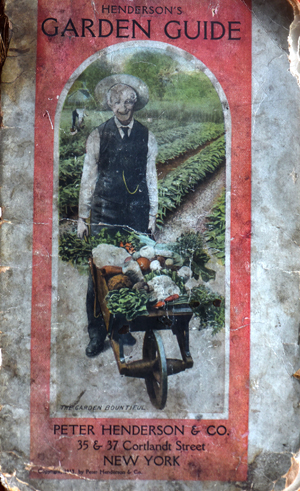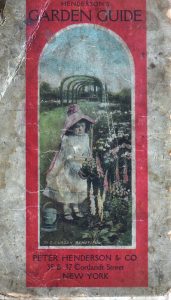Gardening book from 1913 reveals how we used to garden
Posted on: February 7, 2018 | Written By: Doug Oster |
When I was given a soft-covered copy of “Henderson’s Garden Guide” from 1913, I couldn’t wait to read it.
It was given to me at one of our free gardening symposiums, held twice a year for Seed of the Month Club members. The 7-inch by 4-inch so-called pocket-sized book is filled with fascinating garden information that gives us a window into the past.

Henderson’s Garden Guide from 1913 was sent to customers of Pete Henderson & Co. who’s motto was “Everything for the Garden.” This is the front cover of the 64 page book.
“Can you use these?” a woman said as she handed it to me. She was also holding an old copy of “Vegetable Cook Book,” which is featured in a story by Everybody Craves editor Meghan Rodgers.
The garden book was dog-eared with one corner nibbled upon by a rodent, and I found a ginger snap recipe written on stationary from the defunct Universal Atlas Cement Company of Penn Hills (which closed in 1979). My guess is it was used as a bookmark.
The 64-page book was a product of Peter Henderson and Company, a garden supplier extraordinaire founded in 1847 and closed in 1953. Henderson was known as the father of horticulture and ornamental gardening in the United States. The company’s motto was “Everything for the Garden.” They offered flower and vegetable seeds, plants, bulbs, tools and more — including books, of course.
It’s interesting that a century ago this book should begin with these words: “This is an age of the high cost of living. The fundamental cause being the increase of twenty per cent (sic) in our population every decade, which far outstrips the increase in acres tilled.” The author continues to extol the virtues of growing your own food in what was called a “back to the land” movement. Sound familiar?
In an age without radio or TV, and a century before social media, the company also invited readers to help edit the next year’s garden guide by sending their personal stories of unusual or successful gardening experiences along with questions and ideas about what should be included in the book.
With that, the book launches with a query that’s just as frequently asked today, “How early may I plant?” The usual answer, even today, is as soon as the soil can be worked, but what does that mean? For cool weather vegetables, the author says, just wait until temperatures in the shade average 45 degrees. A diagram also shows May 15 as the day to plant corn in Western Pennsylvania, which still makes sense even though these suggestions come from the USDA back in 1910. In today’s climate, many farmers plant about two weeks earlier.
I had to laugh when raised beds were described as an “old style” of planting which should be abandoned in favor of rows running north to south to get the most “forenoon sun.” What’s old is new again as raised beds have become increasingly popular more than 100 years later.
Companion and succession planting are covered expertly along with crop rotation. This book was sent to gardeners when they ordered seeds or other things from the company. It includes a long list of plants and how to sow them, along with diagrams that show what the plant looks like as a seeding. That’s particularly telling for the time. Many beginning gardeners would have no idea about the difference between sprouting lettuce, corn or onions and weeds.

Henderson’s Garden Guide from 1913 was sent to customers of Pete Henderson & Co. who’s motto was “Everything for the Garden.” This is the back cover of the 64 page book.
A listing spells kohl rabi as two words and recommends starting the seed in a hotbed or warm windowsill in mid-February and when strong enough to plant in “well-manured soil” in rows two feet apart with the plants spaced at 9 to 12 inches. That advice still works today although the vegetable is now referred to as kohlrabi.
In old garden book, there is always something referenced that has faded away as a common garden plant, like sea kale (Crambe maritima). It’s a perennial vegetable from the mustard family related to its namesake kale. Shoots are typically cut in spring and then blanched or steamed. The young leaves may be eaten raw or cooked (like spinach). Flower buds may be eaten raw or cooked (like broccoli). Roots may also be eaten raw or boiled and steamed. In “Henderson’s Garden Guide,” gardeners are advised to blanch those early shoots with spent manure or leaf mold and then let the leaves emerge from the mulch. The blanching keeps the shoots tender, making them more palatable, says the author.
Witloof is said to be “The New Christmas Salad” in the book. It’s a large leafed variety of chicory. This is another plant that’s blanched by hilling up the soil around a tight head of leaves. Back then, the roots were dug and stored in a cool cellar, then replanted in succession through the spring.
The book covers a lot of ground in so few pages, with text so tiny, in some cases it needs to be magnified to read. There are instructions for making “manure water,” called manure tea these days, along with specific cultural planting tips for artichokes and other vegetables.
Instructions for sowing more than 200 types of flower seeds are ingeniously listed. Each variety is followed by a capital letter. Find the letter on the next two pages to discover the details for getting them started.
There are a couple pages detailing how to grow sweet pea flowers and preparing, packing and staging them for exhibition. It must have been all the rage to grow these cool weather flowers, because we don’t see them in many gardens here as the summers stop them in their tracks.
Bulbs, perennials, shrubs and roses, lawn care, fertilizing, canning and more are also part of this little book.
The book shows its age when it comes to dealing with insects and other perceived. There’s information on how to kill earthworms, something we know today helps the garden and also are a sign of good soil health. There’s no concern with handling arsenic-laced products or problems using soap made from whale oil.
In many ways, we’ve evolved as gardeners, but there are some things that will never change when it comes to growing plants. In many ways, it’s comforting to know what we’re doing today might be carried on for generations to come.
Doug Oster is editor of Everybody Gardens, a website operated by 535Media, LLC. Reach him at 412-965-3278 or doster@535mediallc.com. See other stories, videos, blogs, tips and more at everybodygardens.com.

Henderson’s Garden Guide from 1913 was sent to customers of Pete Henderson & Co. who’s motto was “Everything for the Garden.” This illustration shows what onions look like when they sprout.